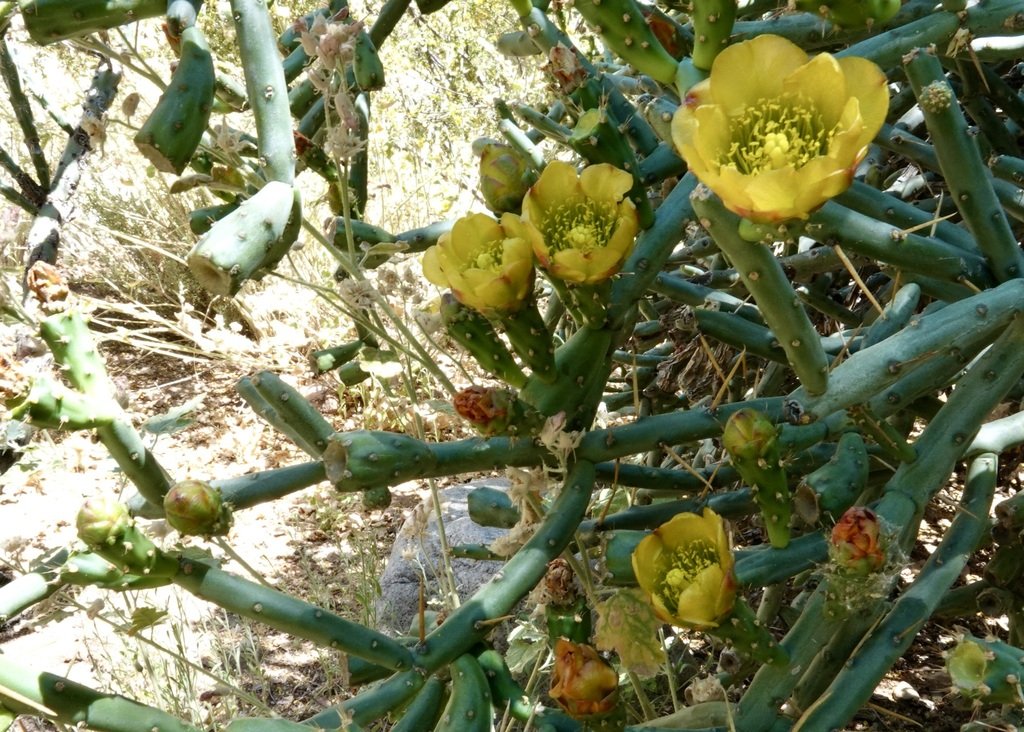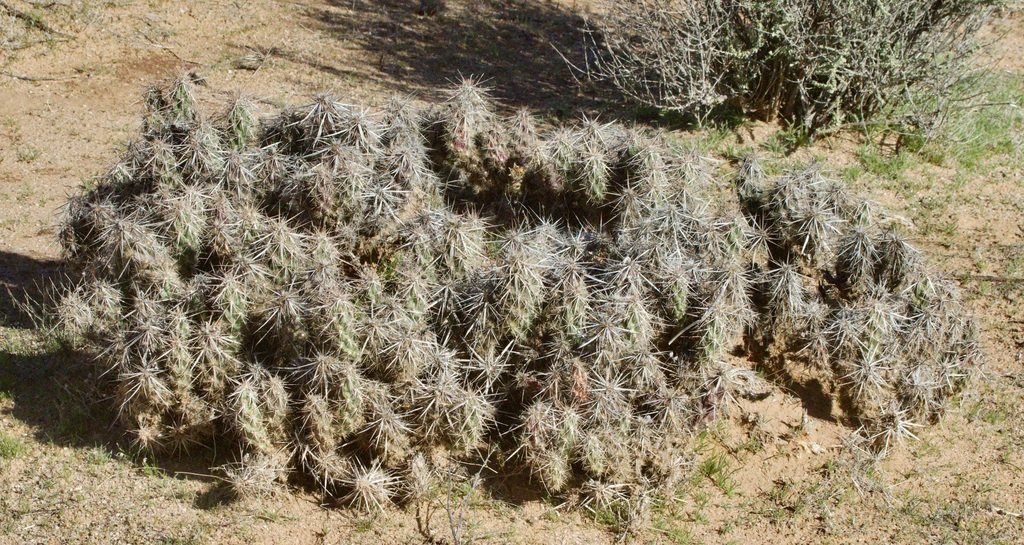Chollas and their Allies
Cylindropuntia, Grusonia, etc.
Probably one of the most despised plants of the desert by people who don’t love the desert, chollas are fascinating and important habitat plants. The are a large part of the general theme of our arid lands—the lands that demand not just love, but respect.
Chollas teach you to hike with mindfulness, pulling us humans out of our self-centered ways. If you don’t pay attention, you may end up with a cholla bud in your calf!
Photo of Teddybear Cacti (Cylindropuntia bigelovii) by Zachary Nielsen, iNaturalist
There are approximately 50 species of Cylindropuntia native to the southwestern and south-central United States, Mexico, and the West Indies. A few plant groups are cholla allies/relatives—cholla-like plants with short stems that grow along the ground in a matted or clumped form with no distinct trunk: Grusonia/Corynopuntia (21 species), Micropuntia (1 species).
All these plants grow best in full sun with low water. Most will appreciate some water once a month or so in summer (when rains have been scarce). Hardiness varies to species. As holds true for most cacti, cholla, though formidable and even what some people call “ugly” (I strongly contest this description) produce gorgeous flowers usually in spring or early summer.
Plant these plants away from high-traffic areas, or in areas you wish to make less traffic-prone.
There are lots of wildlife that take advantage of cholla—packrats use cholla stems for nest protection. Birds like cactus wrens (Campylorhynchus brunneicapillus) make nests in chollas. The Cactus Moth (Cactoblastis cactorum) uses chollas as a larval host. Cholla, like many cacti, are important pollen and nectar sources for many pollinators. Some bee species only use cactus flowers.
Humans use cholla for various purposes. Cholla flower buds are often roasted and eaten, an important food source for people like the Tohono O’odham.
Below are some of the cholla you might come across at specialty nurseries (like ours) to use in your landscape. If you wanna deep dive into any cholla species, we recommend looking at Michelle Cloud-Hughes’ page on chollas.
Peach Springs Canyon Cholla (Cylindropuntia abyssi) are bushy plants up to about 3’ tall. Endemic to northwestern Arizona; known from only from the Grand Canyon and in Peach Springs Canyon, on the Hualapai Reservation in Mohave County. It grows in desert scrub on limestone ledges and hilltops. This species may be a natural hybrid involving C. bigelovii. Greenish-yellow flowers. Hardy to about 20F. Photo by Matthew S., iNaturalist
Buckhorn Cholla (Cylindropuntia acanthocarpa) is generally 3-6’ tall, buckhorn cholla is often quite shrubby, but some plants are treelike and reach up to 12 feet tall. This species has flowers that can be bright yellow to bronze to brick red or even purplish. A variable species native to the Mojave, Sonoran, and Colorado Deserts of North America, into Sonora, Mexico. There are several varieties of this species. Hardy to about 10°F.
Arizona Pencil Cholla (Cylindropuntia arbuscula) are shrubby plants usually about 3-5’ tall but sometimes reaching up to 8-9'. Greenish yellow flowers tinted with bronze to orange on the inner tepals. Native to southern Arizona, south into Sonora. Hardy to about 15°F. Photo by Joanne Lowry, iNaturalist
Teddybear Cholla (Cylindropuntia bigelovii) From the distance this cholla has a soft appearance, giving it the name teddy bear cholla. But of course, it’s a cholla so its not soft. This is one of the more attractive chollas of the world, with its densely spined, yellow stems. Plants are often short but well-branched, reaching about a foot or two tall. But plants can get taller with age, usually up to 5-6’ tall. Of all the chollas, this one seems to have some of the most readily detachable stems—and this species mainly depends on vegetative reproduction. Flowers are a greenish yellow, sometimes with reddish tips. This species is native to Northwestern Mexico, and to the United States in California, Arizona, and Nevada. Photo by Anthony Mendoza, SEINET
Snake Cholla (Cylindropuntia californica) is an upright-growing species that normally reaches about 6’ but can get to about 10’ tall and wide. Flowers are yellow, often with red tips. Snake cholla is native to southern California and Baja California, where it usually grows in coastal sage scrub and chaparral. Hardy to about 20°F. Photo by Vincent Weber, iNaturalist
Davis' Cholla (Cylindropuntia davisii) is a densely branched plant reaching up to about 2’ tall. Flowers are yellow-green, tinged purple-red and age to red-brown. Native to New Mexico and Texas. Hardy to 5°F. Photo by Catherine C. Galley
Silver Cholla (Cylindropuntia echinocarpa) is a variable species, ranging from low, densely branched plants to tree-like shrubs to 6+’ tall. Though we call it “silver cholla” it has many names referring to the color of the plant and can have white, yellow, tan, or occasionally red-brown spines effecting the perception of the plant’s color. Inner tepals of the flowers are light to yellow-green, sometimes suffused with maroon or rose. Native to Arizona, Nevada, California, and Baja California. Reported to be hardy to around 0°F but since this species varies a lot, hardiness is probably also variable. Photo by klaudia, iNaturalist
Chain-fruit Cholla (Cylindropuntia fulgida) is often a tree-like cholla which develops distinctive chains of fruit that hang, reaching up to 10’ tall. The flowers are pink to magenta. Hardy to about 15°F. Native to the Sonoran Desert of central Arizona south into Sonora and Sinaloa, Mexico. Photo by Patrick Alexander, SEINET
Gander's Cholla (Cylindropuntia ganderi) typically grows up to about 4’ tall with stems that emerge from basally-branched plants. The inner tepals of the flowers are greenish yellow, often with reddish tips. Native to the Sonoran desert of Baja California, Mexico, and the adjacent border area of southern California. Hardy to about 15°F. Photo by Colin Barrows, iNaturalist
Tree Cholla (Cylindropuntia imbricata) is a tree or shrub-sized cactus, 3-15' tall; stems jointed and widely branching, with a whorled branching pattern. Flowers are dark pink to red/magenta. In Arizona, New Mexico, Texas, Oklahoma, Kansas, Colorado, into Mexico. Hardy to -10°F. Photo by omcelroy on iNaturalist
Kelvin Cholla (Cylindropuntia × kelvinensis) forms open-crowned trees with whorled branches growing to 6' tall. The flowers are rose to magenta with deep pink filaments, white styles sometimes with reddish-purple tips, and greenish-white stigmas. This is a naturally occurring hybrid between C. fulgida and C. spinosior. Found in Arizona. Probably hardy to around 15°F. Photo by Michelle Cloud Hughes, Opuntiaweb
Candle Cholla Cylindropuntia kleiniae is an openly-branching shrub growing up to 8' tall. The flowers are greenish to reddish at the base with magenta-tinged tips. The filaments are green basally to bronze distally. Native to New Mexico, Texas, south into Mexico. Hardy to -20°F. Photo by Uziel OM, iNaturalist
Christmas Cholla (Cylindropuntia leptocaulis) is a shrubby plant 3-8' tall, sometimes arborescent. Flowers are pale yellow to greenish yellow and sometimes red-tipped. Found on sandy, loamy, or gravelly soils in deserts, grasslands, chaparral, woodlands, flats, bajadas, and slopes in Arizona, New Mexico, Texas, southern Oklahoma, into Mexico. Cold hardy to about 15°F. Photo by Max Licher, SEINET
Munz's Cholla (Cylindropuntia munzii) is a sprawling but arborescent cholla reaching 6-15' tall. Flowers are pale reddish brown. Native in California and Baja California in Sonoran Desert-- flats, hills, sandy to rocky soils. Exact hardiness not known but probably at least into the teens °F. Photo by Colin Barrows, iNaturalist
Coast Cholla (Cylindropuntia prolifera) is a mostly erect, treelike cactus which can approach 6' in maximum height. The flowers are reddish purple and often borne on the fruits of previous seasons. Fruits grow in chains of up to 5 and are green in color. Native to Southern California and Baja California, where it grows in coastal sage scrub, chaparral, and beach and bluff habitat.Hardy to about 15°F. Photo by bradleytsalyuk on iNaturalist
Diamond Cholla (Cylindropuntia ramosissima) is a decumbent or erect and treelike cactus which can approach though often much shorter. The flower is small and orange, pink or brownish in color. It is native to the Mojave and Sonoran Deserts of the Southwestern United States, California, and Northwestern Mexico, and to Baja California. Hardiness can vary but usually hardy into the teens °F. Photo by Morgan Stickrod, iNaturalist
Walkingstick Cactus (Cylindropuntia imbricata ssp. spinosior) grows upright, 4-6' or more. Flowers can be rose to red-purple, bronze-purple, or yellow, sometimes pale greenish yellow. Native to Arizona, New Mexico, Sonora, Chihuahua. Often called Cylindopuntia spinosor. Photo by Liz Makings, SEINET
Thistle Cholla (Cylindropuntia tunicata) is low-growing but spreading to almost 10' wide. Sometimes they can get up to 10' tall but most often they are just a few feet tall. The flowers are greenish-yellow with yellow filaments, green to reddish styles, and greenish-yellow stigmas. Occurs from southern Texas into central Mexico. Cold hardy to about 20°F. Photo by Opuntia Cadereytensis on iNaturalist
Staghorn Cholla (Cylindropuntia thurberi ssp. versicolor) is a shrubby or arborescent plant reaching about 6' or more. Flowers can be yellow-green, yellow to gold or bronze, or red to rose or magenta. Native to Arizona and Sonora. Hardy to 10°F. Also called Cylindropuntia versicolor. Photo by Max Licher, SEINET
Whipple Cholla (Cylindropuntia whipplei) is often low growing, 1-2' tall though rarely getting 6' tall. Flowers yellow to green-yellow. Native to Arizona, Utah, Nevada, Colorado, New Mexico. Very cold hardy to well below 0°F. Photo by Max Licher, SEINET
Wolf's Cholla (Cylindropuntia wolfii) grows up to about 6' tall. The flower is brownish purple outside to yellowish green in the center. Native to California and Baja California. This plant seems to be on the frost tender side and should be protected from hard frost, though it can take some minor, brief frosts. Photo by Eric Koberle, iNaturalist
Devil Club-Cholla (Grusonia emoryi) grows very wide and seldom gets over a foot tall. Yellow flowers occur in late spring. Native to Arizona, New Mexico, Texas, and Chihuahua. Hardiness unkown but at least into the teens °F. Photo by jmbearce on iNaturalist
Kunze Club-Cholla (Grusonia kunzei) can get a little over a foot tall but mostly spreads. Flowers late spring into summer with yellow flowers. Found in Arizona, New Mexico, Sonora, and Baja California. Hardy to the mid 20s °F. Photo by Mark Pollock, iNaturalist
Matted Cholla (Corynopuntia parishii)--formerly Grusonia parishiorum. Yellow flowers in late spring. Native to Arizona, California, Nevada. Photo by ericalboucher, iNaturalist
Sagebrush Cholla (Micropuntia pulchella) Formerly Grusonia pulchella. Native to California, Nevada, Colorado. Very cold hardy--tops die back if conditions too adverse (too dry, too cold), and will re-emerge from roots. Purple-pink flowers late spring, early summer. Very cold hardy. Photo by Janel Johnson, iNaturalist
Casa Rata (Corynopuntia invicta)--formerly Grusonia invicta. May get up to almost 2' tall but usually shorter, spreading very wide. Yellow flowers with red throats in late spring. Hardy to upper 20s°F or more if kept dry in winter. Baja California. Photo by Tania Pérez Fiol, iNaturalist



























